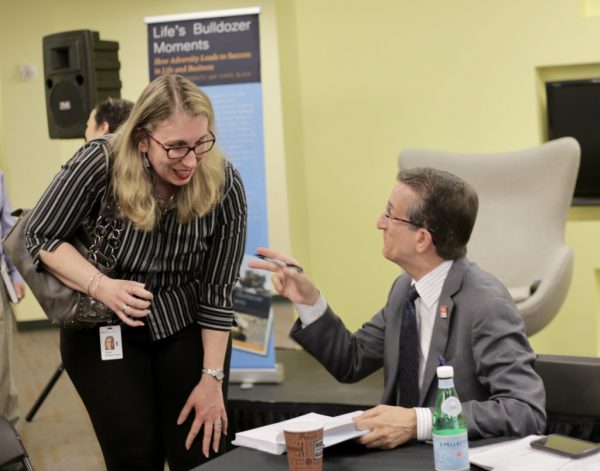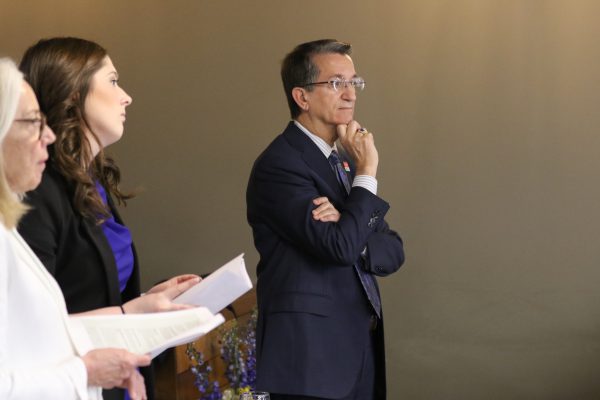When you have less than an hour to speak with a person who is the CEO of a Nasdaq public corporation, the founder of two international philanthropic organizations, an award-winning global health activist, and an author, where does one begin the conversation? It seemed prudent to get to the heart of things, because that’s where Donato Tramuto’s attention is focused–on the heart, or to be more specific, on the soul of a successful, change-making organization.
So that’s where the phone conversation started: what is Donato Tramuto’s philosophy on how successful companies or organizations are built?
“You can’t just do one thing,” Tramuto began. “You need all the pearls on the string.”
He proceeded to name the pearls–of wisdom–one by one.
Vulnerability

“I have worked the gamut of small to medium to large organizations, both private and non-profit. I speak from a perspective of what has worked, not just from a Nasdaq public platform, but rather as a leader with skills.
It all begins with who you are. One must understand one’s own lack of perfection. We must reveal our own vulnerabilities as a leader. We must let people know that we are human.
Even though I’m high profile, I can still foster a learned reaction that I am here for everyone else. I admit and reveal my vulnerabilities. I am as human as anyone.”
Having read Tramuto’s book Life’s Bulldozer Moments: How Adversity Leads to Success in Life and Business –as well as heard him speak publicly–it’s clear that he lives this advice, establishing a warmth and connections with those around him. But beyond this charisma, how does Tramuto implement his leadership philosophy and build successful organizations?
Goals, Measurement, and Reward
“Business is changing. The marketplace in which we live (political, economic, and social) is changing much faster than it was 40 years ago. If you want your company to have a soul, then you have to embrace community. CEOs have a platform for the common good now. They must define a double bottom line and give back. This can be hard for CEOs to accept.
You must first define what you want from your company. Is it inclusiveness? Empowerment? Provocation? Accountability? Then you define three to five goals. And here’s the hard part: you have to be consistent with measuring relative to those goals and then hire, fire, and reward accordingly.
Motivating employees is not about sticks; it’s about carrots. My company has nearly 1,000 employees and they each have a scorecard. There are bonus incentives tied to that scorecard.
“If you get the culture right, then all else will follow. But, it’s like pushing a 5,000-pound flywheel. Changing an organization’s culture takes time and this requires patience.”
People want to feel that they have a purpose. They want to feel that they belong. People want to be successful. It’s a leader’s job to remove the obstacles. Trust kicks in. They belong and they are financially rewarded, but it’s not always about money. As a way of thanking employees, I give extra time off. Delivery and execution generate rewards.
Cultural Norms with Accountability
“There are several styles of leadership. Compassionate leadership does not mean ‘soft’ or simply having empathy. It is about proactive, sincere efforts to design projects that care for employees.
It is not enough to have this style of leadership yourself. Then you need to train everyone else. It is about training everyone to be tender. Then, when the time comes for tough decisions that have to be made and followed, those decisions can be accepted.
Training is a necessary part of the process, not just to convey my philosophy, but to get the whole team on board. The principles around which I build training are Tenderness, Trust, and Tenacity.”
Given the importance of the leadership style in this culture, how does accountability endure after the training? Tramuto stresses two-way communication. And not in ways that you would necessarily expect.
Communications Systems and the Willingness to Embrace Critique
“I give out my cell phone number. Every employee is able to connect with me. Every week I send a voice email. I talk about both the good things and the challenges facing us. Then I have an ‘ask-me-anything’ conference call. Employees can dial in and ask anything, and they can submit questions anonymously.
Once you make yourself available like this, you start getting calls and hearing points of view. One caller said to me, ‘I can see things changing under your leadership.’ That was good news, but the biggest mistake that a leader can make is to fly in like a seagull and then leave. You have to constantly check and evaluate the change that is underway.

In one position that I held, I had to make a big change. I needed to understand the pain of people first. What did my employees need to understand in order to accept the decision? They wanted involvement. They wanted to understand the basis of the decision. We needed to understand their viewpoint in order to help them see the rationale on the business side. Then, after making the change, I needed to be sure that attitudes were alright, rather than having everyone feel abandoned.
It was an eight- to nine-month process. I met with 90 percent of those employees. I said, ‘I do not expect you to trust me today. But as I listen and demonstrate consistency in leadership, I hope you will in the future.’ And then I went around to check on people. What did I find? I found a kind of bullying in pockets of the company, rather than compassion. These bullies were communicating ‘you’re not a manager, you have no voice.’ This was unacceptable, but I wouldn’t have found it if I wasn’t going back and checking all of the time.
I also use bringing in an outside firm to assist with proactive measuring of employee sentiment. When I found that 10 percent of employees called and voiced their opinion to me, but 20 percent went to the outside firm and reported their viewpoints, we decided to introduce something called TINYpulse. This is an online survey product that takes frequent, real-time employee feedback so that you can create a company culture that you can be proud of. Survey questions go out bi-weekly. For example, ‘How happy are you at work?’
The bottom line is that you have be willing to ask questions and be unafraid to receive the answers.”
Stories
“Everybody has a story. We fail as leaders when we don’t ask people for theirs. What is the story of their moment? What is the story of meaning for them? What is the story of their life? Understanding the experiences that motivate and define each other as individuals helps to build trust and ultimately makes us better leaders. I’ve connected with hundreds of people over my book and they’ve shared the adversities that have shaped their lives. It becomes a point of connection.
I have made it my business to know the majority of people’s stories in this company.”
Fortunately for us, Donato Tramuto shares his stories, his pearls of wisdom and insights, so that more people can lead and help organizations find their soul and create positive change.
****
Donato J. Tramuto, the CEO of Tivity Health, Inc.–a leading provider of fitness, nutrition and social engagement programs–received an honorary doctorate at the 2019 Commencement at Saint Joseph’s College of Maine on May 11th. Author of Life’s Bulldozer Moments: How Adversity Leads to Success in Life and Business (Hamilton Press), Tramuto is a recognized innovator and industry leader with more than 35 years of healthcare experience. He is a transformational leader whose own adversity and challenges have created a leadership mantra of compassion with results.
Tramuto is the founder of Health eVillages, a non-profit organization which provides state-of-the-art mobile health technology in the most challenging clinical environments. He is also the chairman and founder of the Tramuto Foundation, an international non-profit foundation that provides college scholarships each year to students who have overcome adversity in their lives. Additionally, the Foundation has supported hundreds of organizations whose goal is to make the world a more just and fair place, including a partnership with Saint Joseph’s College to create Maine’s first Institute for Integrative Aging and its associated programming.
